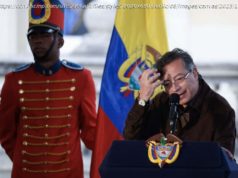If Trump wants to take down China in the trade wars, the NAFTA talks won’t help.
Donald Trump came to office with a vision of a raging global trade war. In some tellings, the war is his glorious conquest. In others, Hillary Clinton launched the invidious assault, which is being waged against American workers through the North American Free Trade Agreement (a deal negotiated before her husband ever took office, let alone her time as secretary of state) and the Trans-Pacific Partnership (which Clinton disavowed as a candidate). Whoever started the fire, it is clear that Trump sees trade battles as defining his presidency. But confusion over the basic details of the strategy—Should America be fighting Canada? China? Both at once?—have ensured that this war will have few winners.
Friday, the White House formally notified Congress that it intends to renegotiate NAFTA. Mexico has signed onto the deal, and while Canada has not yet, it still could. (The Trump team has tried to make a sense of urgency out of its rotten relationship with Mexico, which will have a new president in December who is even less well disposed to being associated with Trump than the current one.)
Even in their unfinished form, the NAFTA talks so far amount to a rhetorical and political victory for the president. Whether any deal is ever ratified—it would be voted on by the next Congress, which may be hostile to Trump—he has forced America’s trade partners to reckon with his worldview. He can tell American workers he fought for them, just as he promised. But in economic terms, the story of America’s first postwar unfree trade deal is far more mixed. And as a strategic matter, the NAFTA fight leaves the country ill-prepared to face the far more consequential economic struggle with China.
Trump’s NAFTA strategy: bluff, rebrand, declare victory
To assess Trump’s victory, it’s essential to recall that he didn’t start from nothing. President Barack Obama also came to office promising to renegotiate NAFTA. In fact, he essentially did. His TPP deal included both Canada and Mexico, covered many of the same areas the new NAFTA proposal does, and brought in nine other countries. Trump dropped TPP in favor of negotiating sequentially with Mexico and then Canada, but ended up in a similar place. “What is known about the agreement so far shows only modest changes,” wrote the economist Tyler Cowen.
The new NAFTA proposal does diverge from TPP in at least one crucial way, however: It makes North America’s vast automotive trade less free. Two provisions in the proposed deal make the difference. First, it tightens NAFTA ’s already strict “rules of origin,” regulations that require most of a given car’s component parts to come from North America. Second, it requires that a big chunk of the car be built by workers making a minimum wage that’s set higher than what Mexican auto workers currently make. Only if both of those conditions are met will the cars avoid the default 2.5 percent tariffs the U. S. imposes on cars from other countries. The Mexican government estimates that 70 percent of its U. S. automotive exports will meet the two conditions. In other words, the new NAFTA rules would require auto manufacturers to jump through hoops in order to avoid a fairly small tariff. Some simply won’t do it. Those that do will pass their costs on to consumers. What does all that amount to? Simply put, car prices will rise.
The TPP would have gone in the other direction. The rules negotiated by Obama, and rejected by the Trump administration, would require fewer local parts, not more, in order for a car to avoid tariffs, and there were no similar provisions for minimum auto wages. That was a big political problem for the deal. “The TPP will create more incentives for companies to move operations to low wage countries,” the leaders of the United Automobile Workers declared in 2015. Now Trump’s new deal has the autoworkers union intrigued. In a statement with other major unions Monday, the UAW said it was waiting for more details but generally saw the NAFTA talks as “on track.”
The contrast between the two deals is revealing. Robert Lighthizer, the former steel lobbyist who serves as chief negotiator in his role as U. S. trade representative, has testified that his goal is to bring manufacturing back to the United States. The new NAFTA deal shows the lengths he’s willing to go to do that. The new rules deliberately make trade in cars less free, in order to shelter American jobs. “It’s not clear to me how you could characterize their goal as anything other than protectionism,” said Simon Lester, a trade-law expert at the Cato Institute.
When Lighthizer was confirmed by the Senate last year, he brought something entirely new to the job: contempt for America’s tradition of unbridled free trade. Trade policy, he wrote in 2008, “is merely a tool for building a strong and independent country with a prosperous middle class.” That point of view has driven an approach to trade conflict that resembles the total-war mentality of World War II. Anything goes in the effort to bring manufacturing jobs back to America—even measures that might otherwise damage the broader industries that house those workers. It’s not just Mexico. The administration’s tariffs on China take the same approach. According to research by the Peterson Institute for International Economics’s Mary Lovely and Yang Liang, the tariffs “target multinational supply chains.” In other words, instead of targeting exclusively Chinese companies that dump goods into the U. S. market, the Trump administration is targeting the Chinese-made components Google uses to build the Nest thermostat sold in the U. S. As with Mexico, the administration is punishing companies that manufacture abroad rather than in the U. S. That’s a big change from the decades America spent building deals like NAFTA that let its companies spread their supply chains across the world.
The other prime example of the total-war mentality is the tactics used to bring Mexico and Canada to the negotiating table. The administration has invoked national security to raise tariffs on steel and aluminum imports. It’s one thing to bluster and bluff in service of a better deal for Americans. That’s standard for any negotiator. But effectively declaring Canada and Mexico—not to mention the European Union and other treaty allies—a potential national-security threat crossed a line other American presidents wouldn’t. “There’s a difference between safeguarding an industry and saying, ‘America’s national security is at risk,’” said Carla Hills, the former U. S. trade representative who negotiated NAFTA under the first Bush administration, in an interview in June. “There’s no question, and I recognized it at the time, that trade is very closely linked to the bonds that create security.”
Why Donald Trump’s trade war will fail
The administration inverted that relationship. The idea of a national-security threat appears little more than a pretext to give the United States a better negotiating position against its friends and allies. Lighthizer is primarily concerned about protecting the American steel industry from cheap Chinese imports, but once that’s done, why not use the leverage created against the NATO -member Canada? “They are unjustified and illegal,” said Canadian Foreign Minister Chrystia Freeland on Friday. But U. S. officials seem unfazed. In Senate testimony in July, Lighthizer explained, “Not to suggest that army tanks are coming in from Canada, but if you made a decision that it’s in the national interest to save the steel industry, then you have to put in place a program that works.” That remark is telling. Axios reported on sharp disagreements within the administration over whether to impose those tariffs. Officials seem to come and go within Trump’s swirling vision of a trade war. Some, like Lighthizer, can apply their own strategy to that chaos, and make the best of opportunities like the metals tariffs.






